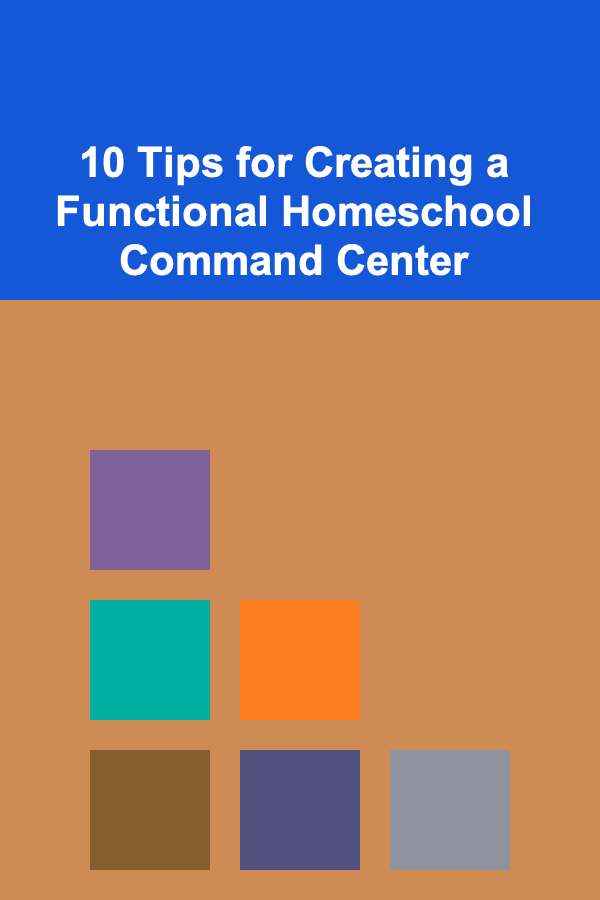
10 Tips for Creating a Functional Homeschool Command Center
ebook include PDF & Audio bundle (Micro Guide)
$12.99$10.99
Limited Time Offer! Order within the next:

As homeschooling continues to gain popularity, the need for an organized, efficient space to manage lessons, supplies, and schedules is more important than ever. A homeschool command center is essentially the nerve center of your homeschooling operation---it's where everything is stored, planned, and coordinated. A well-designed command center can help create a sense of structure, reduce distractions, and enhance the overall homeschooling experience.
Whether you're new to homeschooling or a seasoned pro, creating a functional homeschool command center can make a world of difference in maintaining an organized, calm, and productive learning environment. Here are 10 practical tips to help you design the ultimate homeschool command center.
Choose the Right Location
The first step in setting up a homeschool command center is choosing the best location. This will depend on your home's layout, available space, and how much noise or distractions you can tolerate during homeschooling hours.
- Designated Space: Ideally, your homeschool command center should be in a quiet area with minimal distractions. This could be a spare room, a dedicated corner in the living room, or even a portion of a hallway.
- Accessibility: The space should be easily accessible to both you and your children, especially when it comes to daily schedules, learning resources, and schoolwork.
- Good Lighting: Ensure there's ample natural light or adjustable artificial lighting. Bright, natural light can improve focus and energy levels for both kids and adults.
- Proximity to the Learning Space: If possible, position the command center near the area where the actual lessons take place. This way, you can easily access materials and resources as needed without disrupting the flow of the class.
Incorporate a Centralized Calendar System
One of the most important features of a homeschool command center is a clear and organized calendar system. With homeschooling, flexibility is key, but a well-structured schedule helps ensure that your days run smoothly.
- Wall Calendar or Whiteboard: A large wall calendar or a dry erase board is perfect for tracking monthly, weekly, and daily plans. Write down important dates, upcoming assignments, field trips, or extracurricular activities.
- Digital Calendar: Consider using a digital calendar synced across devices for better collaboration. Many homeschooling families find it helpful to use Google Calendar or other scheduling tools.
- Time Blocks: Break your schedule into manageable time blocks. For example, a morning session could be dedicated to math, followed by a break, and then a science lesson. Time blocking reduces overwhelm and ensures that no subject is neglected.
Set Up Dedicated Learning Zones
Within your homeschool command center, it's important to have clearly defined zones for different activities. This helps kids (and you) stay focused and organized throughout the day.
- Workstation for Each Child: Set up a desk or table for each child, if possible. This can be a small, individual workspace equipped with the tools they need to succeed, like a notebook, pens, and a computer. The more personal and organized their space, the more likely they will feel motivated.
- Storage for Supplies: Allocate areas for storing books, writing materials, art supplies, and science equipment. Consider using shelving, storage bins, or file cabinets for easy access and tidiness.
- Group Area for Hands-On Activities: If you plan to do group activities, such as arts and crafts or experiments, create a shared table or floor space where your children can work together. This is especially useful for collaborative projects.
Organize Your Educational Materials
A homeschool command center is only as effective as the organization behind it. Make sure all your educational materials are easy to access and clearly labeled.
- Bookshelves: Use bookshelves or baskets to organize curriculum books, worksheets, reference materials, and notebooks. Keeping similar items together helps you locate them quickly when needed.
- File Folders or Binders: Set up filing systems for each subject or project. File folders, binders, or magazine holders work well for keeping loose papers, completed assignments, and materials organized.
- Label Everything: Label boxes, drawers, shelves, and bins to make it easy for both you and your children to locate what they need without having to search.
Create a Routine Board or Task List
To stay on top of daily tasks and ensure that lessons are progressing, consider setting up a routine board or task list. This can be a dry erase board, chalkboard, or magnetic whiteboard where you can post the day's to-dos.
- Task Reminders: For younger children, a visual reminder board can help them stay focused and engaged. Use pictures or icons alongside words to visually represent their tasks.
- Checklist for the Day: A checklist can be especially helpful for older students. It provides structure and helps them track their progress throughout the day. Add a checkbox next to each task, and once it's completed, they can check it off for satisfaction.
- Highlight Special Activities: Use a color-coded system to highlight any special lessons or activities for the day, such as a field trip, guest speaker, or art project.
Incorporate Technology Smartly
Technology can be a powerful tool in the homeschool command center, but it's important to use it wisely. Too much tech can be distracting, but when used in moderation, it can enhance learning.
- Dedicated Devices: Assign specific devices, such as tablets or laptops, for school use. This keeps your children from getting distracted by unrelated apps or social media.
- Educational Apps & Websites: Incorporate educational tools and apps that align with your curriculum. There are apps for everything from learning math facts to practicing foreign languages.
- Limit Screen Time: Set boundaries on screen time for non-educational purposes. Consider using apps that help monitor and control screen usage to make sure technology is being used productively.
Create a Homework Station or Assignment Area
Having a designated area for completing assignments is crucial for maintaining focus and consistency. This can be a separate table or a corner of your homeschool command center.
- Homework Area: The homework station should have all the materials your child needs to complete their assignments, including pencils, erasers, calculators, rulers, and reference books.
- Comfortable Seating: Invest in ergonomic furniture to ensure that your child can sit comfortably and maintain focus for longer periods. This is especially important as kids get older and assignments become more intensive.
- Distraction-Free Zone: Set this area away from potential distractions such as the TV, toys, or other noisy areas of the home. A quiet, focused environment leads to better productivity and faster completion of work.
Incorporate Inspirational Decor
The homeschool command center should be a space that motivates your children and fosters a love of learning. Simple decor and visual inspiration can play a huge role in making the space feel welcoming and exciting.
- Motivational Quotes: Post educational or inspirational quotes on the walls. You can include phrases like "The journey of a thousand miles begins with one step" or "Mistakes are proof that you're trying."
- Student Work Display: Showcase your child's best work or special projects on a bulletin board, corkboard, or wall-mounted frames. It will help them feel proud of their accomplishments and motivate them to continue working hard.
- Personalized Elements: Allow your children to decorate their workspaces or areas with things that reflect their personality, such as their favorite colors, hobbies, or interests. A personalized space feels more like their own and encourages ownership of their learning.
Ensure Flexibility and Adaptability
While structure is key in a homeschool command center, it's equally important to create a space that can adapt to your family's needs. Homeschooling is dynamic, and the setup of your command center should reflect that.
- Adjustable Furniture: Consider using adjustable desks or tables that can grow with your child or change their learning needs. You can also have multi-functional furniture that serves as storage or seating.
- Modular Storage: Use modular storage systems that can be reconfigured as needed. This allows you to reorganize the space as your children get older and their needs change.
- Expandable Learning Areas: Designate additional spaces or areas where you can bring in new materials, books, or tools as your homeschooling journey evolves. This could include creating space for a science experiment area, reading nook, or art station.
Keep it Clean and Clutter-Free
An organized space is essential for maintaining productivity and focus, but cleanliness is also critical. A clutter-free environment promotes mental clarity and a positive atmosphere for learning.
- Daily Clean-Up Routine: Establish a daily routine where everyone pitches in to tidy up their workspace. Encourage your children to clean up after each activity to maintain an organized command center.
- Declutter Regularly: Keep your homeschool command center free from unnecessary items. Every few months, go through your materials and discard or donate items that are no longer needed.
- Use Storage Solutions: Invest in storage solutions like baskets, bins, and drawer organizers to keep items neatly stored away when not in use.
Conclusion
A well-designed homeschool command center can greatly improve the efficiency and enjoyment of your homeschooling experience. By carefully selecting the right location, organizing educational materials, creating dedicated learning zones, and incorporating systems for task management, you can create a functional and inspiring space that encourages both learning and organization.
Above all, remember that your homeschool command center should reflect your family's unique needs and style. With these 10 tips, you can create an environment that fosters creativity, productivity, and a love of learning---making homeschooling a more enjoyable experience for everyone involved.
Reading More From Our Other Websites
- [Organization Tip 101] How to Set Up a System for Organizing Home Repair Tools
- [Needle Felting Tip 101] Common Mistakes New Needle Felters Make (And How to Avoid Them)
- [Home Family Activity 101] How to Build a Family Science Experiment Day at Home
- [Home Family Activity 101] How to Organize a Family Book Club
- [Home Lighting 101] How to Choose the Right Vanity Lighting for Your Bathroom
- [Personal Care Tips 101] How to Select Personal Care Products That Suit Your Lifestyle
- [Personal Finance Management 101] How to Teach Financial Education to Kids
- [Home Space Saving 101] How to Save Space in Your Kitchen Without Compromising Functionality
- [Organization Tip 101] How to Create a Packing Station for Donation Drives
- [Home Maintenance 101] How to Implement Smart Home Organization Tips to Boost Efficiency and Reduce Clutter

How to Set Up a Checklist for Book Club Member Roles and Responsibilities
Read More
How to Stage a Home for the Winter Season
Read More
How to Update Your Kitchen on a Budget Without Sacrificing Style
Read More
How to Use Humor Responsibly in Your Speeches
Read More
Top Tips for Successfully Lowering Student Loan Interest Rates Through Refinancing
Read More
How To Discover New Approaches to Obesity Treatment
Read MoreOther Products

How to Set Up a Checklist for Book Club Member Roles and Responsibilities
Read More
How to Stage a Home for the Winter Season
Read More
How to Update Your Kitchen on a Budget Without Sacrificing Style
Read More
How to Use Humor Responsibly in Your Speeches
Read More
Top Tips for Successfully Lowering Student Loan Interest Rates Through Refinancing
Read More